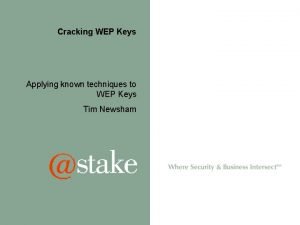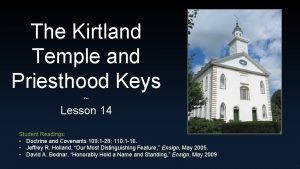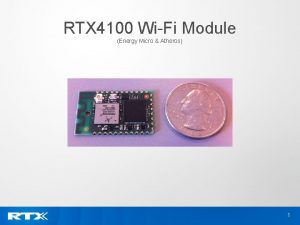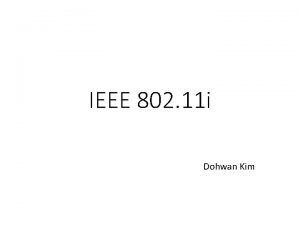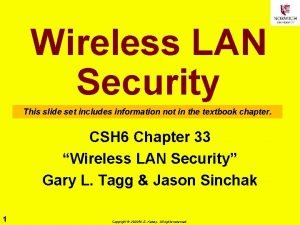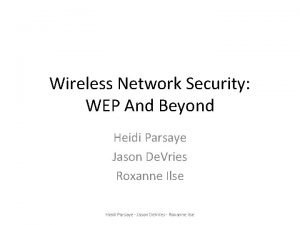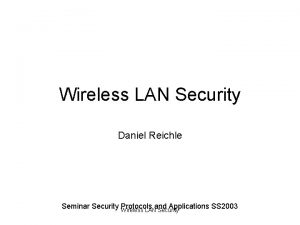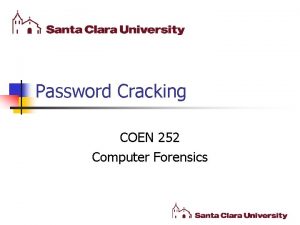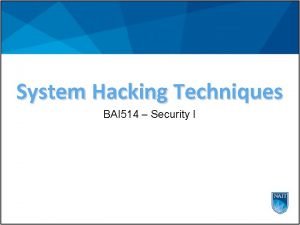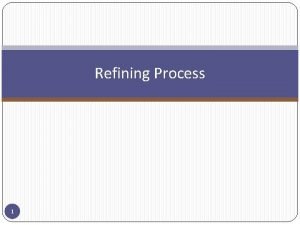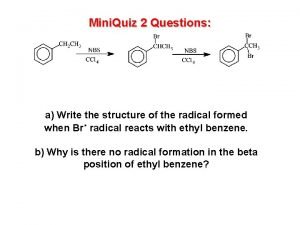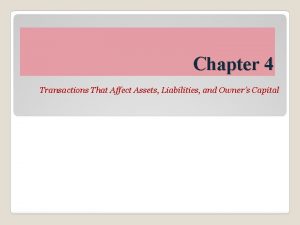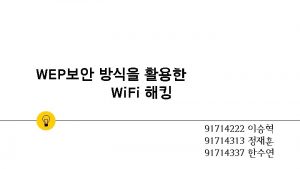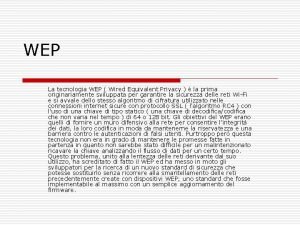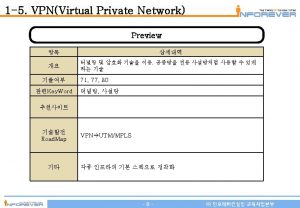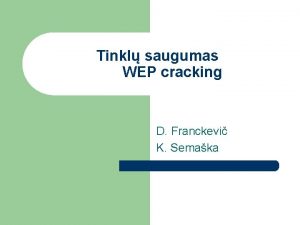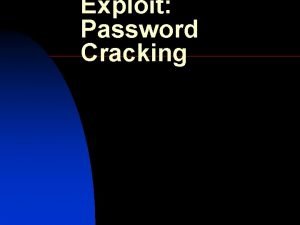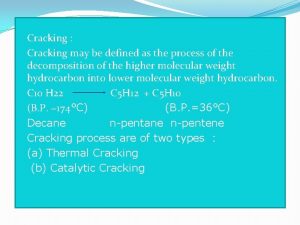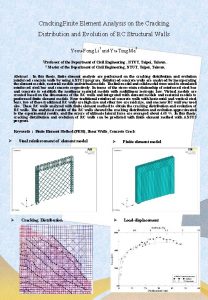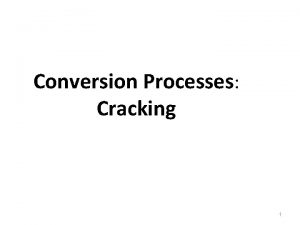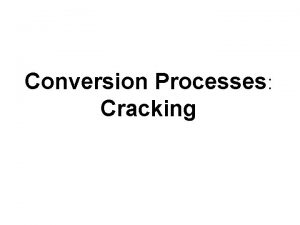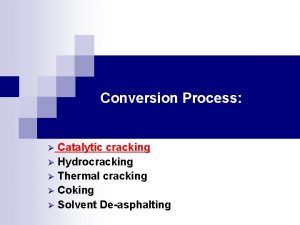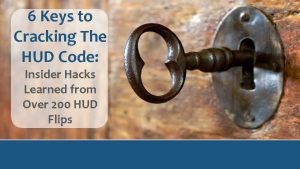Cracking WEP Keys Applying known techniques to WEP



































- Slides: 35

Cracking WEP Keys Applying known techniques to WEP Keys Tim Newsham

© 2001 Introduction § Developed WEP key cracking software – Dictionary attack on the key generators – Dictionary attack on raw keys – Brute force of the 64 -bit key generator § Analyzed Key Generators § Did not perform new cryptanalysis on the WEP protocol § Did not look at 802. 1 x and Radius @STAKE, INC.

© 2001 Talk overview § Motivation § WEP protocol overview § WEP keying § WEP key generators § A WEP Cracker § Results § Related Work @STAKE, INC.

© 2001 Why Perform Dictionary attacks on WEP? § Security is as good as the weakest link § Key cracking attacks the human problem § But Isn’t WEP already broken? – Key cracking is often simpler to implement and perform – Key cracking can be less time consuming @STAKE, INC.

© 2001 Wired Equivalent Privacy § Purpose – bring the security of wired networks to 802. 11 § Provides Authentication and Encryption § Uses RC 4 for encryption – 64 -bit RC 4 keys – Non-standard extension uses 128 -bit keys § Authentication built using encryption primitive – Challenge/Response @STAKE, INC.

© 2001 WEP Encryption CRC 802. 11 Frame Header Payload ICV 32 § ICV computed – 32 -bit CRC of payload @STAKE, INC.

© 2001 WEP Encryption 4 x 40 Key 1 Keynumber Key 2 Key 3 Key 4 § ICV computed – 32 -bit CRC of payload § One of four keys selected – 40 -bits Key 40 @STAKE, INC.

© 2001 WEP Encryption IV keynumber 24 8 § ICV computed – 32 -bit CRC of payload § One of four keys selected – 40 -bits § IV selected – 24 -bits, prepended to keynumber @STAKE, INC.

© 2001 WEP Encryption 64 IV Payload Key ICV RC 4 Payload § ICV computed – 32 -bit CRC of payload § One of four keys selected – 40 -bits § IV selected – 24 -bits, prepended to keynumber § IV+key used to encrypt payload+ICV @STAKE, INC.

© 2001 WEP Encryption WEP Frame Header IV keynumber Payload ICV § ICV computed – 32 -bit CRC of payload § One of four keys selected – 40 -bits § IV selected – 24 -bits, prepended to keynumber § IV+key used to encrypt payload+ICV § IV+keynumber prepended to encrypted payload+ICV @STAKE, INC.

© 2001 WEP Decryption 4 x 40 Key 1 Keynumber Key 2 Key 3 Key 4 § Keynumber is used to select key Key 40 @STAKE, INC.

© 2001 WEP Decryption 64 IV Payload Key ICV RC 4 § Keynumber is used to select key § ICV+key used to decrypt payload+ICV Payload ICV @STAKE, INC.

© 2001 WEP Decryption Payload ICV CRC Header Payload ICV’ 32 § Keynumber is used to select key § ICV+key used to decrypt payload+ICV § ICV recomputed and compared against original @STAKE, INC.

© 2001 WEP Authentication § Uses WEP encryption primitives – Nonce is generated and sent to client – Client encrypts nonce and sends it back – Server decrypts response and verifies that it is the same nonce. § Authentication is optional @STAKE, INC.

© 2001 128 -bit Variant 24 104 IV Key Payload 128 -bits ICV RC 4 Payload § Purpose – increase the encryption key size § Non-standard, but in wide use § IV and ICV set as before § 104 -bit key selected § IV+key concatenated to form 128 -bit RC 4 key ICV @STAKE, INC.

© 2001 WEP Keying § Keys are manually distributed § Keys are statically configured – Implications: often infrequently changed and easy to remember! § Four 40 -bit keys (or one 104 -bit key) § Key values can be directly set as hex data § Key generators provided for convenience – ASCII string is converted into keying material – Non-standard but in wide use – Different key generators for 64 - and 128 -bit @STAKE, INC.

© 2001 Key Entry Example @STAKE, INC.

© 2001 64 -bit key Generator @STAKE, 40 x 32 bits 34 f 8 a 9 27 M y a h e s r s a P ee 61 7 b f 7 p s ab a 3 35 59 seed PRNG 40 iterations 12 e 7 a 3 98 62 c 3 f 3 32 bits § Generates four 40 -bit keys 7 f 6 a 8 e a 3 59 . . . § ASCII string mapped to 32 -bit value with XOR § Value used as seed to 32 -bit linear congruential PRNG § 40 values generated from PRNG, one byte taken from each 32 -bit result INC.

© 2001 64 -bit Generator Flawed! § Ideally should have at least 40 -bits of entropy § Key entropy is reduced in several ways @STAKE, INC.

© 2001 ASCII Mapping Reduces Entropy M y a h e s r P s a p s 32 bits § ASCII string mapped to 32 -bits § XOR operation guarantees four zero bits – Input is ASCII. High bit of each character is always zero – XOR of these high bits is also zero – Only seeds 00: 00: 00 through 7 f: 7 f: 7 f can occur @STAKE, INC.

© 2001 PRNG Use Reduces Entropy 40 x 32 bits PRNG 40 iterations 34 f 8 a 9 27 ee 61 7 b f 7 ab a 3 35 59 . . . – For each 32 -bit output, only bits 16 through 23 are used – Generator is a linear congruential generator modulo 2^32 § Low bits are “less random” than higher bits § Bit 0 has a cycle length of 2^1, Bit 3 has a cycle length of 2^4, etc. . – The resultant bytes have a cycle length of 2^24 – Only seeds 00: 00: 00 through 00: ff: ff result in unique keys! @STAKE, INC.

© 2001 @STAKE, Entropy of 64 -bit Generator is 21 -bits – The ASCII folding operation only generates seeds 00: 00: 00 through 7 f: 7 f: 7 f § High bit of each constituent byte is always zero – Only seeds 00: 00: 00 through ff: ff: ff result in unique keys – Result: Only 2^21 unique keys generated! § Only need to consider seeds 00: 00: 00 through 00: 7 f: 7 f with zero high bits INC.

© 2001 @STAKE, 128 -bit Generator 104 bits My Passphrase. My Pass… MD 5 032 f 6 d 8 e 8392… … 8 df 926 a 64 bits § One 104 -bit key is generated § ASCII string is extended to 64 -bytes through repetition § MD 5 of resulting 64 -bytes is taken § 104 -bits of output selected § Key strength relies on the strength of MD 5 and of the ASCII string INC.

© 2001 @STAKE, Designed and Implemented a WEP Cracker § Proof of concept: bells and whistles left out § Perform dictionary attack against WEP keys – Find keys generated from a dictionary word – Find keys that are ASCII words § Consider each of the four 64 -bit WEP keys or the single 128 -bit WEP key § Perform brute force of the weak 64 -bit WEP generator § No support for other brute force attacks INC.

© 2001 @STAKE, Structure of WEP Cracker Guess Generator Map To Keys § Packet collector § Guess Generator § Mapping guesses to WEP keys § Key verifier Key Verifier Packets Success? INC.

© 2001 @STAKE, Packet Collector § Collect the appropriate packets needed for guess verification – Collects 802. 11 DATA packets – Two packets collected § Reads from pcap-format file – Simplifies design and allows for off-line cracking – Capture utilities such as Prism. Dump already output to this format INC.

© 2001 Making Guesses § Dictionary attack – Read wordlist from file – Lots of room for improvement. For example, rule-based word generation. § Brute force of generator – Generate sequential PRNG seeds between 00: 00: 00 and 00: 7 f: 7 f @STAKE, INC.

© 2001 Mapping Guesses to Keys § Direct translation of ASCII to key bytes – Five ASCII bytes mapped to a single 64 -bit WEP key – Thirteen ASCII bytes mapped to the 128 -bit WEP key – Truncation of long words, zero-fill for short words § Use of the key generator functions – Map ASCII to keys with 64 -bit generator – Map ASCII to keys with 128 -bit generator – Map PRNG seeds to keys with 64 -bit generator @STAKE, INC.

© 2001 Key Verification § Authentication (Challenge/Response) packets – Easiest to verify § Challenge/Responds provides known plaintext – Not ideal - Infrequent and optional § Data packets – Verify that decrypted packets are well-formed – Verify that ICV is correct – Inexact: can result in false-positives § Verifying against several packets increases assurance @STAKE, INC.

© 2001 ICV Verification § Get IV and keynumber from packet § Form RC 4 key from IV+key[keynumber] § Decrypt payload+ICV § Recompute ICV and compare § Probability of false match is 2^-32 – Matching two packets gives high assurance @STAKE, INC.

© 2001 @STAKE, Results § Proof of concept constructed – Dictionary attack on ASCII keys and 64 - and 128 -bit key generators – Brute force of 64 -bit generator § Performance on PIII/500 MHz laptop – Brute force of 64 -bit generator in 35 seconds, 60, 000 guesses/second – 60, 000 guesses/second against 64 -bit ASCII keys – 45, 000 guesses/second against 128 -bit generated keys – 55, 000 guesses/second against 128 -bit ASCII keys INC.

© 2001 Brute Force of Keys § Brute force of 40 -bit keys is not practical – About 210 days on my laptop – ~100 machines could perform attack in reasonable time – Better attacks exist § Brute force 104 -bit keys is not feasible – 10^19 years @STAKE, INC.

© 2001 @STAKE, Implications § 64 -bit generator should not be used § If ASCII keys or generated keys are used, string should be well chosen – Use similar guidelines as when choosing a login password § Random 40 -bit keys have reasonable strength § Well chosen 104 -bit keys, generated or not, are strong INC.

© 2001 @STAKE, Related work – Bad News § Ian Goldberg et al and Jesse Walker – WEP encryption is fundamentally flawed – Attack times on the order of a few days § Bill Arbaugh et al – WEP authentication can be performed without knowing the key – Extended Goldberg’s attacks against WEP encryption – easier to perform § Places upper limit on cracking efforts – 1 -2 days INC.

© 2001 That’s All Folks… § tnewsham@stake. com § Source code provided on CD or at http: //www. lava. net/~newsham/wlan/ § Source code is Public Domain § Questions? @STAKE, INC.
 Dichotomous key generator
Dichotomous key generator Priesthood keys restored in kirtland temple
Priesthood keys restored in kirtland temple Key of content writing
Key of content writing Wifi stack architecture
Wifi stack architecture Wep weaknesses
Wep weaknesses Wep algorithm
Wep algorithm Waps wep
Waps wep Aoi wep
Aoi wep Wep
Wep Daniel reichle
Daniel reichle Ufo wardriving 4
Ufo wardriving 4 Wep
Wep Social engineering password cracking
Social engineering password cracking Hydrogen assisted cracking
Hydrogen assisted cracking Cracking of octane
Cracking of octane Whip-cracking in the czech republic and slovakia
Whip-cracking in the czech republic and slovakia Hammering wood together physical or chemical
Hammering wood together physical or chemical Cracking the sales management code pdf download
Cracking the sales management code pdf download Cracking the facebook coding interview
Cracking the facebook coding interview Silver bullet cracking
Silver bullet cracking Pharmaceutical application of emulsion
Pharmaceutical application of emulsion Password cracking definition
Password cracking definition Catalytic cracking
Catalytic cracking Hypocotyl necrosis in french bean is due to
Hypocotyl necrosis in french bean is due to Crude oil processing steps
Crude oil processing steps Cracking ap human geography definition
Cracking ap human geography definition Chemistry cracking
Chemistry cracking Plastic shrinkage cracking repair
Plastic shrinkage cracking repair Corliss jackson
Corliss jackson Cracking the periodic table code
Cracking the periodic table code Why do we need cracking
Why do we need cracking Cyclopentadiene cracking
Cyclopentadiene cracking Fonctions techniques
Fonctions techniques Applying for a driver’s license illegally may result in:
Applying for a driver’s license illegally may result in: Assets increase on which side
Assets increase on which side The nail extension underside should:
The nail extension underside should:
